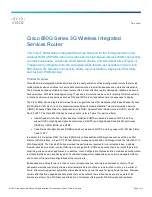
Advanced rate selection lets you configure the following settings for the 2.4 GHz and
5 GHz radio bands in a WiFi network:
•
Fixed multicast rate: The multicast traffic transmission rate that you select is
automatically applied. The rates that you can select are the basic multicast rates that
the radio band supports.
•
Rate control: The rate that you select is automatically applied to beacon and other
management frames and to control and data frames. If you enable rate control, you
can set the density level, which consists of four components that are described below.
That is, the density level includes much more than the client density (the number
and proximity of clients in the WiFi network).
The available settings for the density level in the WiFi network depend on the WiFi
mode in which the radio operates. (For more information about WiFi modes, see
Change the WiFi mode for a radio on page 88.)
You can set a density level of 0 (actually spanning 0–4, the default setting), 1 (spanning
1–4), 2 (spanning 2–4), 3 (spanning 3–4), or 4. The setting is then applied to the
following
interdependent
components, which you cannot set individually precisely
because they are interdependent:
-
Density: The density (the number and proximity) of clients in the WiFi network.
(The density is one of the four components of the density
level
.) A setting of 0
means a very low client density. A setting of 4 means a very high client density.
-
Compatibility: The compatibility with WiFi modes for legacy clients in the WiFi
network. A setting of 0 means compatibility with 802.11b/g/n/ax clients. A setting
of 4 means compatibility with 802.11g/n/ax clients but not with 802.11b legacy
clients.
-
Overall performance: The throughput speed for the clients in the WiFi network.
A setting of 0 means a reduced performance. A setting of 4 means an optimal
performance. As an example, you can deliberately select a reduced performance
if you require a very wide coverage area.
-
Coverage: The area that the WiFi network must cover. A setting of 0 means a
very wide coverage area. A setting of 4 means a very narrow coverage area. As
an example, you can deliberately select a very narrow area if you require an
optimal performance.
Another way to describe the density level is that a selected level is mapped to a
corresponding client density level, WiFi mode, minimum legacy rate, beacon rate, and
minimum Modulation Coding Scheme (MCS) rate.
User Manual
209
Manage the Advanced WiFi
Features for a WiFi network
Insight Managed WiFi 6 AX3000 Access Point Model WAX618
















































